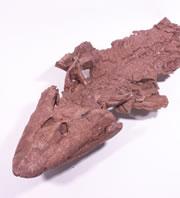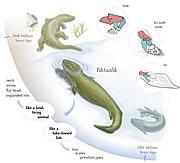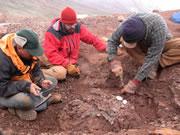 The fossilized remains of Tiktaalik show a crocodile-like creature with joints in its front arms.credit Ted Daeschler
The fossilized remains of Tiktaalik show a crocodile-like creature with joints in its front arms.credit Ted DaeschlerA crucial fossil that shows how animals crawled out from the water, evolving from fish into land-loving animals, has been found in Canada.
The creature, described today in Nature1,2, lived some 375 million years ago. Palaeontologists are calling the specimen from the Devonian a true 'missing link', as it helps to fill in a gap in our understanding of how fish developed legs for land mobility, before eventually evolving into modern animals including mankind.
“Tetrapods did not so much conquer the land, as escape from the water.”
John Maisey
American Museum of Natural History, New York
Several samples of the fish-like tetrapod, named Tiktaalik roseae, were discovered by Edward Daeschler of the Academy of Natural Sciences in Philadelphia, Pennsylvania, Neil Shubin of the University of Chicago in Illinois, Farish Jenkins of Harvard University in Cambridge, Massachusetts and colleagues.
The crew found the samples in a river delta on Ellesmere Island in Arctic Canada; these included a near-complete front half of a fossilized skeleton of a crocodile-like creature, whose skull is some 20 centimetres long.
The beast has bony scales and fins, but the front fins are on their way to becoming limbs; they have the internal skeletal structure of an arm, including elbows and wrists, but with fins instead of clear fingers. The team is still looking for more complete specimens to get a better picture of hind part of the animal.
Plugging the gap
 The new find helps to fill a gap in the record of how fish evolved into land-loving animals. Click here to see enlarged graphic.credit Kalliopi Monoyios
The new find helps to fill a gap in the record of how fish evolved into land-loving animals. Click here to see enlarged graphic.credit Kalliopi MonoyiosCreatures with features of both fish and land-living animals have been found before. Fish that may have been beginning to 'walk' in shallow water have been found from about 385 million years ago, and fish with limbs that bear digits have been seen from more than 365 million years ago.
Specimens that fall into the gap, such as Tiktaalik, help researchers to work out the details of this transition. The newly found animal has a structure on its head that looks like a small gill slit that is on its way to becoming an ear, for example, and a long snout that would have been suited to catching prey on land.
" Tiktaalik substantially narrows the gap in the fossil record of the fish-tetrapod transition," says Per Ahlberg of Uppsala University in Sweden.
" Tiktaalik was probably an unwieldy swimmer," says John Maisey, a palaeontologist at the American Museum of Natural History in New York. It probably lived in shallow waters, says Maisey, only hauling itself on to land temporarily to escape predators. "Tetrapods did not so much conquer the land, as escape from the water," he says.
Treasured find
 The crew picks over rocks and bones despite the dismal weather.credit Ted Daeschler
The crew picks over rocks and bones despite the dismal weather.credit Ted DaeschlerDaeschler and Shubin set off to find this missing link in the evolutionary chain back in 1999. The pair targeted Ellesmere Island after noticing that it was listed in an undergraduate textbook as exposed Devonian rock that had not previously been explored for vertebrate fossils.
The desolate area was reachable only by plane, and the weather was so bad that field work could only be done for about two months each summer. The team first walked around the rocky outcrops looking for fossils of plant life that indicated stream or delta sediments, in order to target areas that had once hosted shallow waters. "That is where the action is on the fish-to-tetrapod transition," says Daeschler.
By 2000 they had found fossils with intriguing fins in the eroding rocks. "In 2004, we really scored, finding three partial skulls and numerous jaws," recalls Daeschler.
ADVERTISEMENT
Shubin remembers finding one simply by wandering off to sit on a rock for his lunch break. "I looked over at a wall; there was a Tiktaalik snout looking out of the cliff at me. I couldn't believe my eyes. I knew the rest of the skeleton was behind it. We were high fiving right and left."
Visit our fishthatcrawledoutoft.html">newsblog to read and post comments about this story.
American Museum of Natural History, New York
